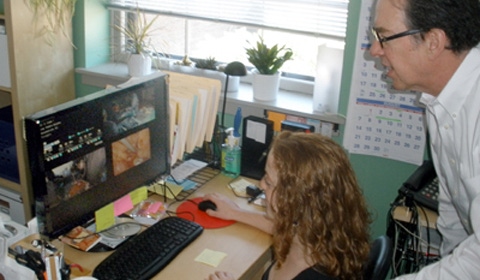Meet Steve Wilcox. He’s the founder of Design Science (Philadelphia), a firm that focuses on human factors, the user interface, and product design. He’s also an African noble and an esteemed member of MD+DI’s Editorial Advisory Board. He has an affinity for collecting antique housewares, enjoys vacationing in Provence, France, and is a big fan of President Eisenhower.
July 18, 2011

|
Steve Wilcox looks on as a member of the Design Science team analyzes video from a laparoscopic gastric bypass procedure. Conducting ethnographic research involves studying how a product is used. In many cases, the start of this process involves setting up cameras (Design Science also developed its own camera system) in the operating room to record the surgeon and staff (including who does what) during a procedure. As many as 20 surgeries are recorded. Design Science uses its own proprietary software to analyze the video, from up to four angles at once. From there, procedure maps are created. |
MD+DI’s board members play a critical role in working with the brand’s content team. They provide important feedback about what we’re doing right, what we’re doing wrong, and what we should be doing.
Wilcox started Design Science in 1991 because he wanted to focus on the healthcare industry. At the time, he was working in human factors at Herbst LaZar Bell and wondered how a human factors design firm would fair as a standalone entity. “In the consumer product area, you do some valuable work and some nonsense; I didn’t want to be doing the nonsense,” says Wilcox. “[At Design Science], I’ve never had a client ask me to do something that wasn’t valuable to the user.”
The team at Design Science comes from a variety of disciplines, including design, biomedical engineering, and social sciences, as well as human factors programs. Wilcox is also exploring bringing physicians onboard and teaching them the research aspect of the job as a new employee model. But most importantly, he wants people who have a passion for healthcare. His staff works on as many as 15 projects at a time and about half of them are in the field at any given time. On average, it takes about three months to complete a project. Wilcox is in the office about two days a week, and the rest of his time is spent traveling and in client meetings.
“We develop tools that serve as the foundation for product development,” says Wilcox. “We’ve created a niche for ourselves.” Procedure maps provide an at-a-glance view of how surgeons and clinicians are using instruments in the OR. |
|
| |
These posters pull the most key information in an effort to support decision making in the boardroom. It can be a much more effective way of explaining what is happening visually versus the less-appealing method of reading through pages and pages of text. | The storyboard sheds light on how companies can design or modify a device to make procedures as efficient as possible. Some storyboards use personas and analyze the OR layout, clinician workflow, the number of instrument exchanges, a surgeon’s stress level. These storyboards don’t “dumb down” the data—they transform the information to make it accessible. |
Most Challenging Part of the Job: Managing both his busy staff (the team includes video and data analysts, designers, and programmers) and clients and ensuring that the complicated projects are completed on time. The firm generally works for the same clients over and over. For example, it has completed about 500 projects for Ethicon Endo-Surgery.
Most Rewarding Part of the Job: “When I walk into a hospital and see the devices we’ve worked on. We’ve had a hand in about 50% of devices [that are used] in hospitals.” He also takes pride in the fact that his firm is making an impact on medical device usability and reducing the likelihood of error.
A special thanks to Steve for letting MD+DI into Design Science for a few hours.
About the Author(s)
You May Also Like




